Shakhtar Donetsk successfully completed the double against Real Madrid in the 2020/21 UEFA Champions League.
The win leaves the Ukrainian side in total control of their knockout round destiny. With the win, Shakhtar have now matched Real Madrid’s seven points, hold the tiebreaker by virtue of their two victories over the Spanish giants and sit just a point behind Borussia Mönchengladbach. Depending on the result of the Real Madrid versus Mönchengladbach game, Shakhtar could need a win against Inter Milan to advance, but their destiny is fully within their hands.
Zinedine Zidane’s side still control their destiny as well, but the loss now puts them in a position where they must defeat Mönchengladbach to progress. With Zidane’s job security on the line, the next two matches are critical for this Real Madrid side.
In this tactical analysis, the first look at the role Toni Kroos played in the first half within his side’s tactics, then progress to show how Shakhtar countered with their defensive press. Though Real Madrid had a strong first half, they were unable to put the ball in the back of the net. This analysis will conclude with a look at why Real Madrid failed to beat the Shakhtar press, looking specifically at how their ineffective wing play limit limited their opportunities on goal.
Lineups
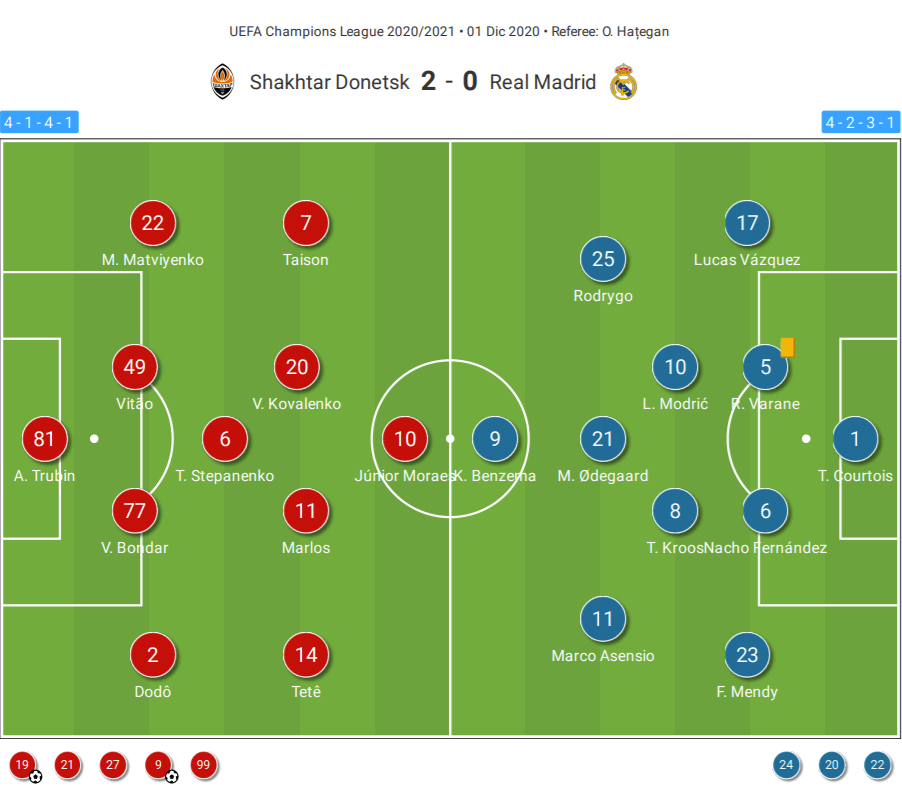
With Casemiro on the bench, Zidane went with the 4-2-3-1 that he has used in recent weeks. Thibaut Courtois received the start in goal with a backline consisting of Lucas Vázquez, Raphaël Varane, Nacho Fernández and Ferland Mendy. Luka Modrić and Toni Kroos operated as the double pivots while the line of attacking midfielders was formed by Rodrygo Goes, Martin Ødegaard and Marco Asensio. Up top, Karim Benzema returned from injury to make the start.
For Shakhtar, Luís Castro used the same 4-1-4-1 formation that he had used in the first match against Real Madrid. He called upon the 19-year-old Ukrainian international, Anatoliy Trubin, to make another start in goal. The backline consisted of Dodô, Valeriy Bondar, Vitão and Mykola Matviyenko. In midfield, Taras Stepanenko was the lone pivot with Viktor Kovalenko and Marlos in front of him. Taison made the start on the left while Tetê earned his place on the right. That left Júnior Moraes as the lone striker, though he would exit the game with an injury in the 25th minute, leaving Dentinho to replace him.
Kroos dictates play
In the first match between these two sides, we saw Shakhtar set out in a narrow 4-1-4-1 to deny Real Madrid entry through the central channel. Zidane knew that Ukrainians would take a similar approach in this match up. Without the deep-lying playmaking services of Sergio Ramos, he had to find a way to position the team to play over or around the Shakhtar middle block.
That solution was dropping Kroos between Varane and Nacho.
In the build-up, we saw the two centre-backs split into the half spaces. That opened the central channel for Kroos. With the ball at his feet and little pressure from the Shakhtar defence, Kroos was able to use his range and accuracy to play over the press and into the wings.
In the example below, we find Kroos joining Varane and Nacho at the back while Vázquez and Modrić occupied the space between Real Madrid’s back and top lines.
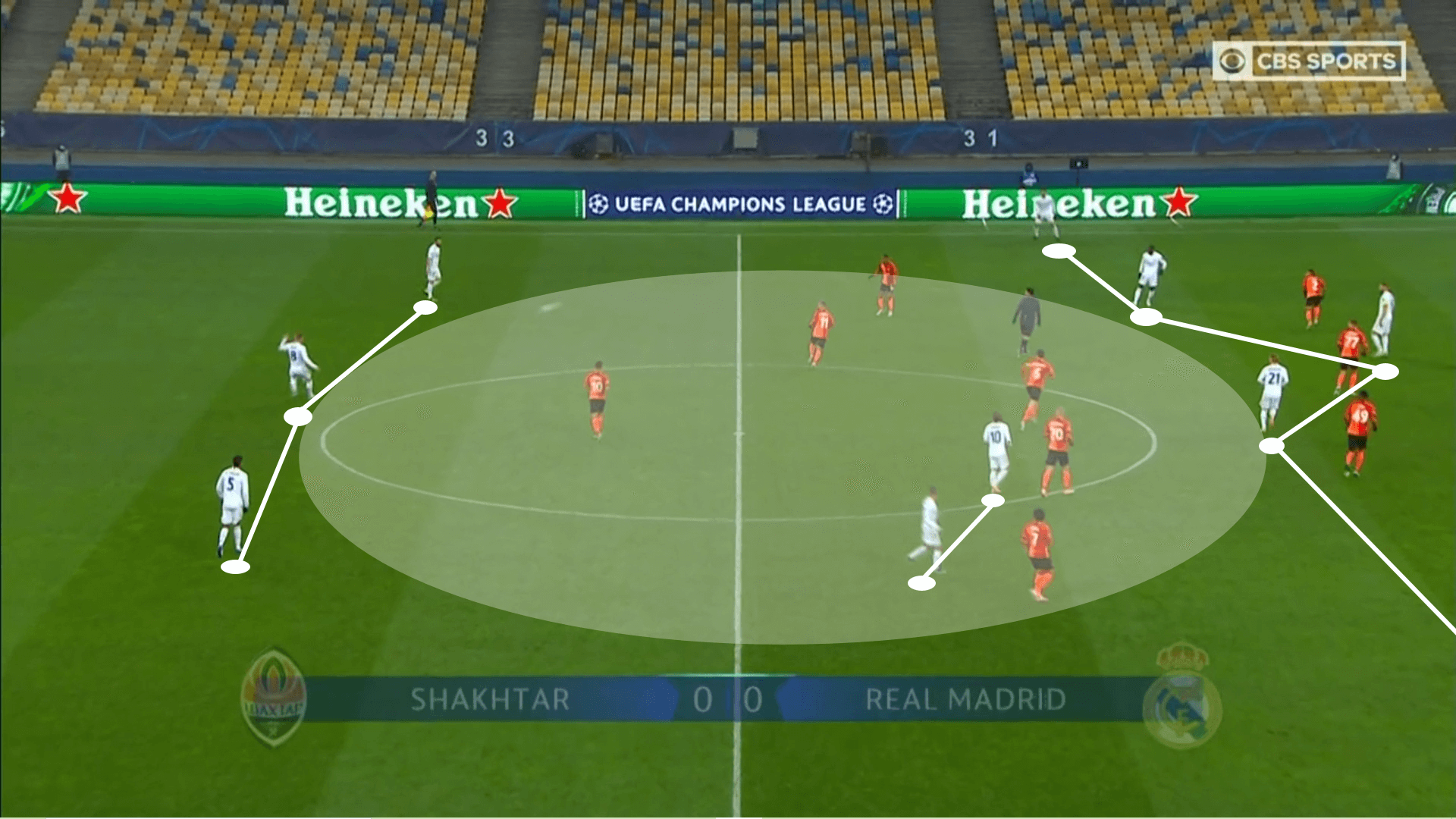
It’s interesting to note that Vázquez, the converted forward, frequently moved into the half space and the central channel as an inverted winger well Mandy was positioned higher up the pitch. With Real Madrid using a 3-2-5 to engage the Shakhtar press, there was a high central overload, restricting the horizontal reach of the defence. That allowed Kroos to swing the ball into the left and right wings.
Below, we see a long pass from Kroos over the defence into the path of Rodrygo. With Benzema positioned between Vitão and Matviyenko, he created additional space for Rodrygo in the wings. In this instance, it was Mendy moving into the half space as an inverted winger, leaving Vázquez to remain wide to the right.

The first half saw Real Madrid create a few quality chances, mostly at the feet of Asencio, but the club was unable to capitalise. The tactical decision to skip the midfield meant that Real Madrid did not have to play into Shakhtar’s compact pressing structure.
Instead, they used a central overload along the Shakhtar backline to create room for the wingers to take on playmaking roles. This was especially important as the side looked to enter the final third. Once they entered the final third, players like Ødegaard and Modrić could then find pockets of space to play around the low block.
Shakhtar Donetsk’s pressing structure and rest defence
Of all the tactical ideas in play during this match, it was Shakhtar’s pressing structure that was most influential. Castro entered the match with the idea that if he could restrict Real Madrid’s access to the central region of the pitch, he could shift playmaking responsibilities to the La Liga champion’s wingers. In a sense, he was directly challenging Asencio, Rodrygo, Mendy and Vázquez to beat him his side.
This pressing structure essentially removed the creative influences of Benzema and Ødegaard for large portions of the game.
For the majority of the match, Shakhtar maintained a 30-yard range with their horizontal pressing and 15 to 20 yards on the vertical side. While that did leave space for Real Madrid to run into, the Spanish side was largely unable to take advantage of the additional room. The few occasions that they were able to play over the press and latch onto the end of a long pass, Shakhtar’s defensive recovery and a strong goalkeeping effort from Trubin kept Los Blancos off the score sheet.
In the example below, we see the 4-1-4-1 press in play with the two wide midfielders taking a deeper position than the two central attacking midfielders. This is the exact defensive tactic Castro had used in the first leg against Real Madrid. Stepanenko’s role as the six was to deny entry into Ødegaard. For the most part, he was highly effective.
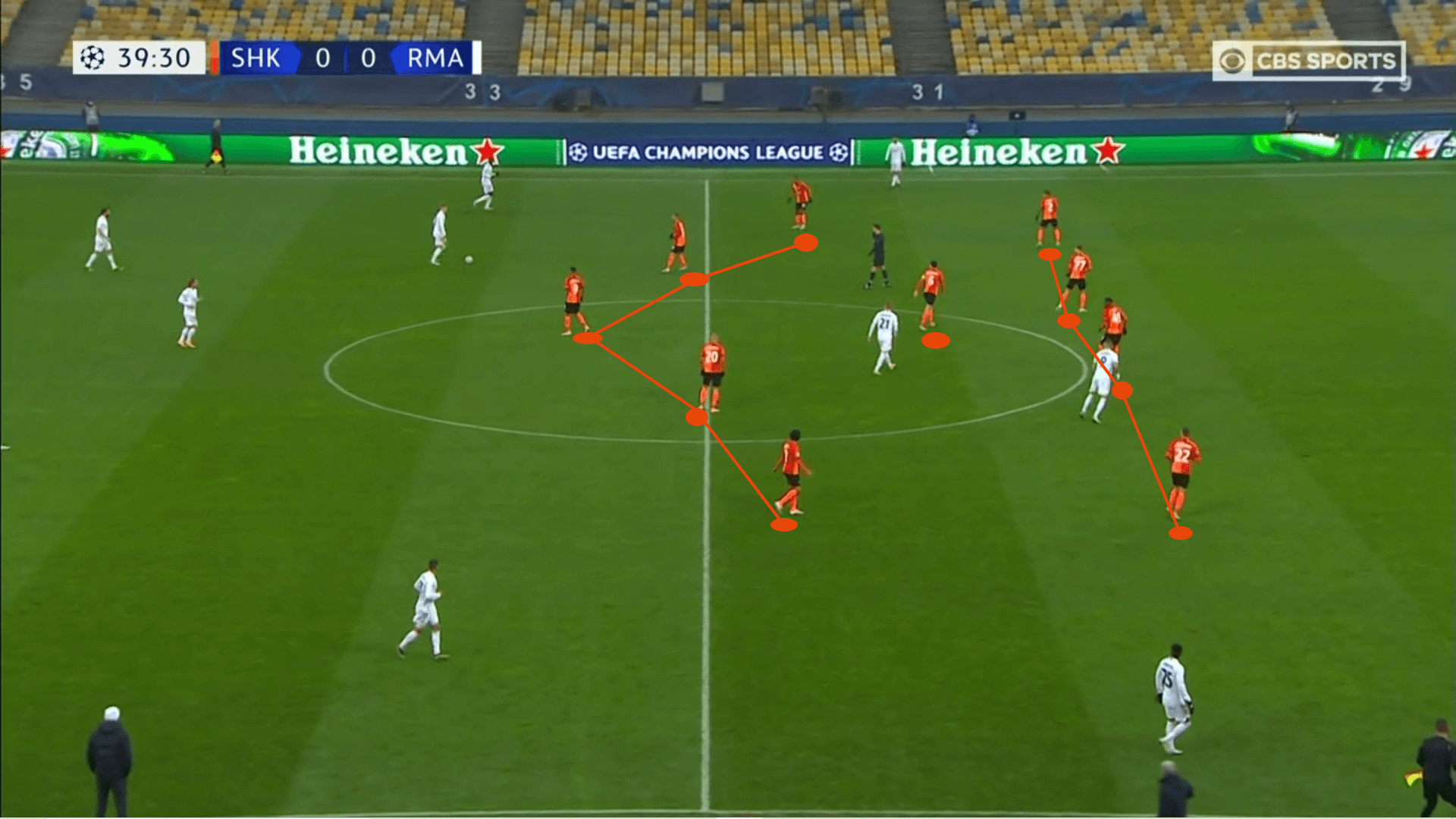
With no space to play between the Shakhtar Donetsk lines, Real Madrid was forced to either play over or around the press. That’s exactly what Castro wanted.
The beauty of Shakhtar’s pressing tactics was that it allowed for a fluid transition into the attack. As you see in the image below, all four wing players moved up a line while the three central midfielders occupied the central part of the pitch to deny counterattacking opportunities to Real Madrid.
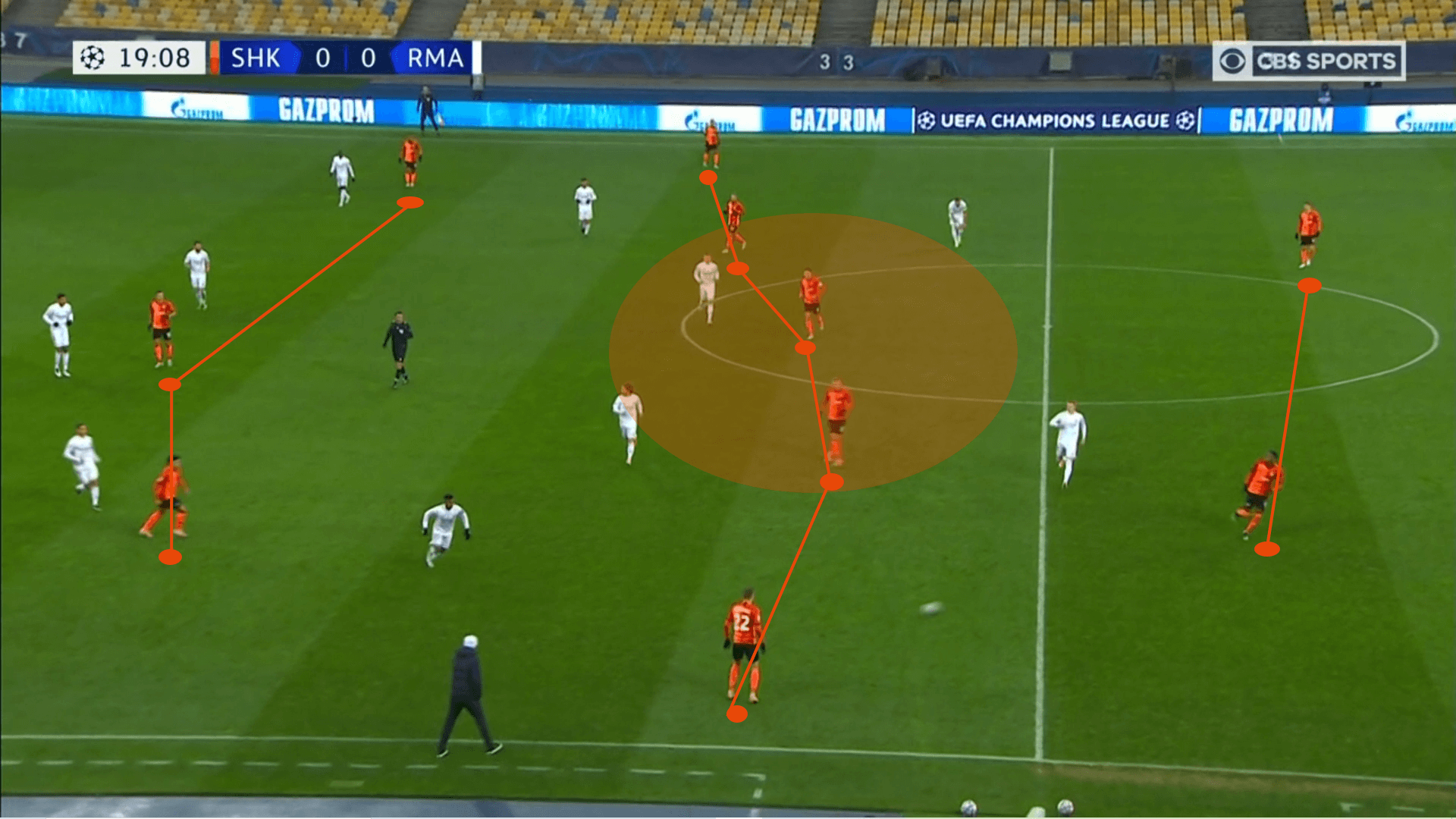
Real Madrid did not record a single counterattack in this match. That’s in large part due to the rest defence Castro had in place. His side always had coverage at the back, midfield numbers to counterpress and numbers high to limit line-breaking passes from the defenders.
When Shakhtar was called into transition defence, the team’s defensive commitment was exemplary. Shortly after a corner kick, Real Madrid tried to break into a counterattack, finding Benzema high up the pitch with Asensio in front of him. As Benzema attempted the pass, Shakhtar managed to recover, get a touch and deflect the ball for an easy recovery.
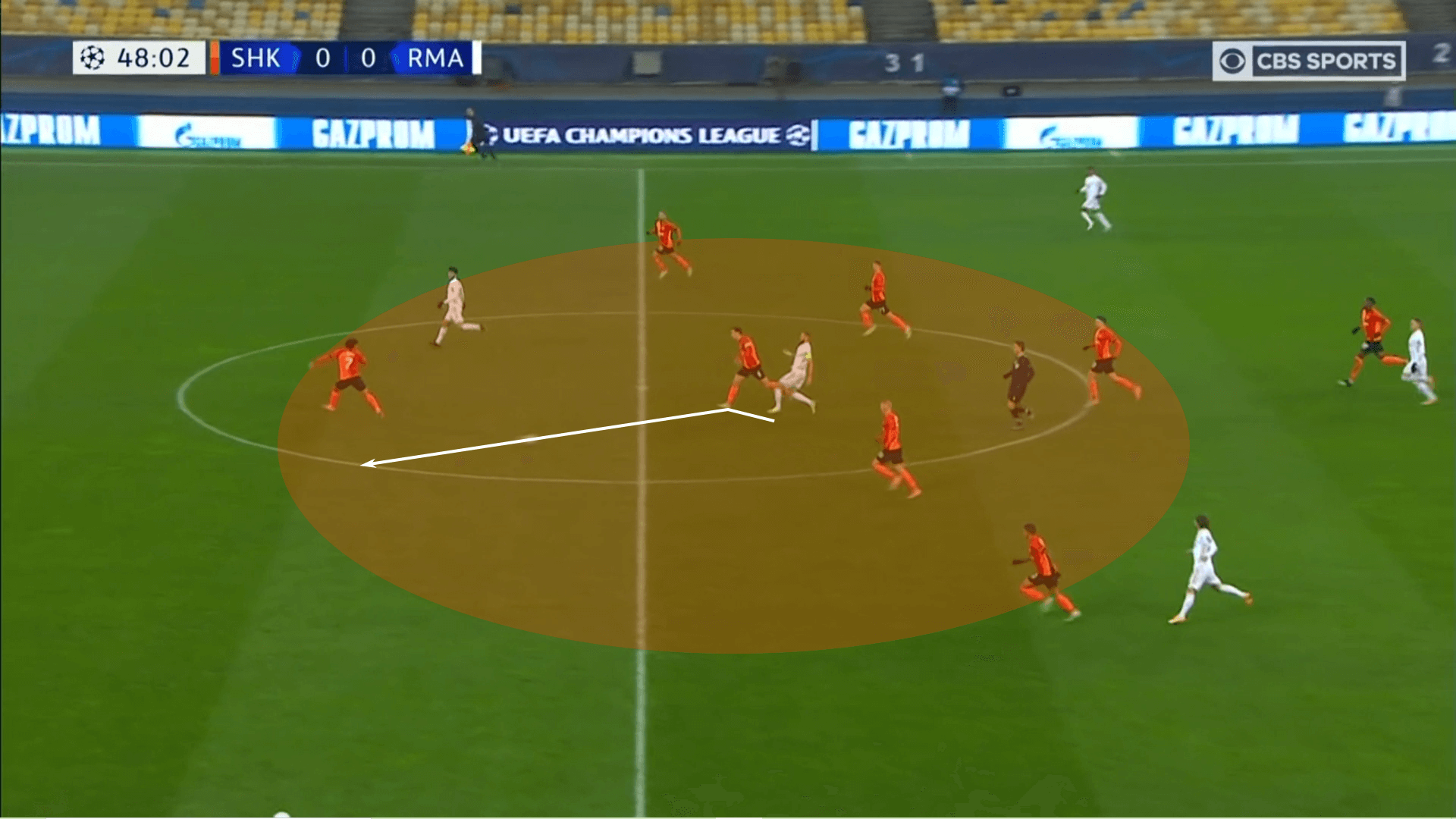
From a defensive standpoint, Shakhtar’s defensive tactics proved too much for Real Madrid. Though the away side had a few decent chances in the first half, they simply did not have an answer for Shakhtar in the second. Some half time adjustments from the home side allowed them to better limit the balls over the top, forcing Real Madrid to play wide and allowing Shakhtar to focus on defending against passes from the wings.
Real Madrid’s inability to break the Shakhtar press
Though Real Madrid had a strong first half showing, they were ultimately unable to convert the few chances they were given. That storyline changed in the second half as Shakhtar was able to choke out any meaningful attacking threats with ease. It was already mentioned that Castro wanted to deny entry into the central channel and force Real Madrid to progress through the wings. They were especially effective in doing so during the second half.
One attacking idea we saw from Real Madrid in the first half was targeting players high in the half spaces. That typically gave them a 2v1 in the wide areas of the pitch. When Kroos wasn’t distributing the ball, it was the centre-backs who were looking to play into those high half space targets.
Below we see Modrić receiving a pass from Varane. As Marlos drops back to press Modrić, the Croatian takes a nice little touch around his defender, finding a more central space to combine with his central teammates. Notice that the only players within the Shankhtar press are Modrić, Ødegaard and Benzema, each playing roughly in line with Shakhtar’s back four.
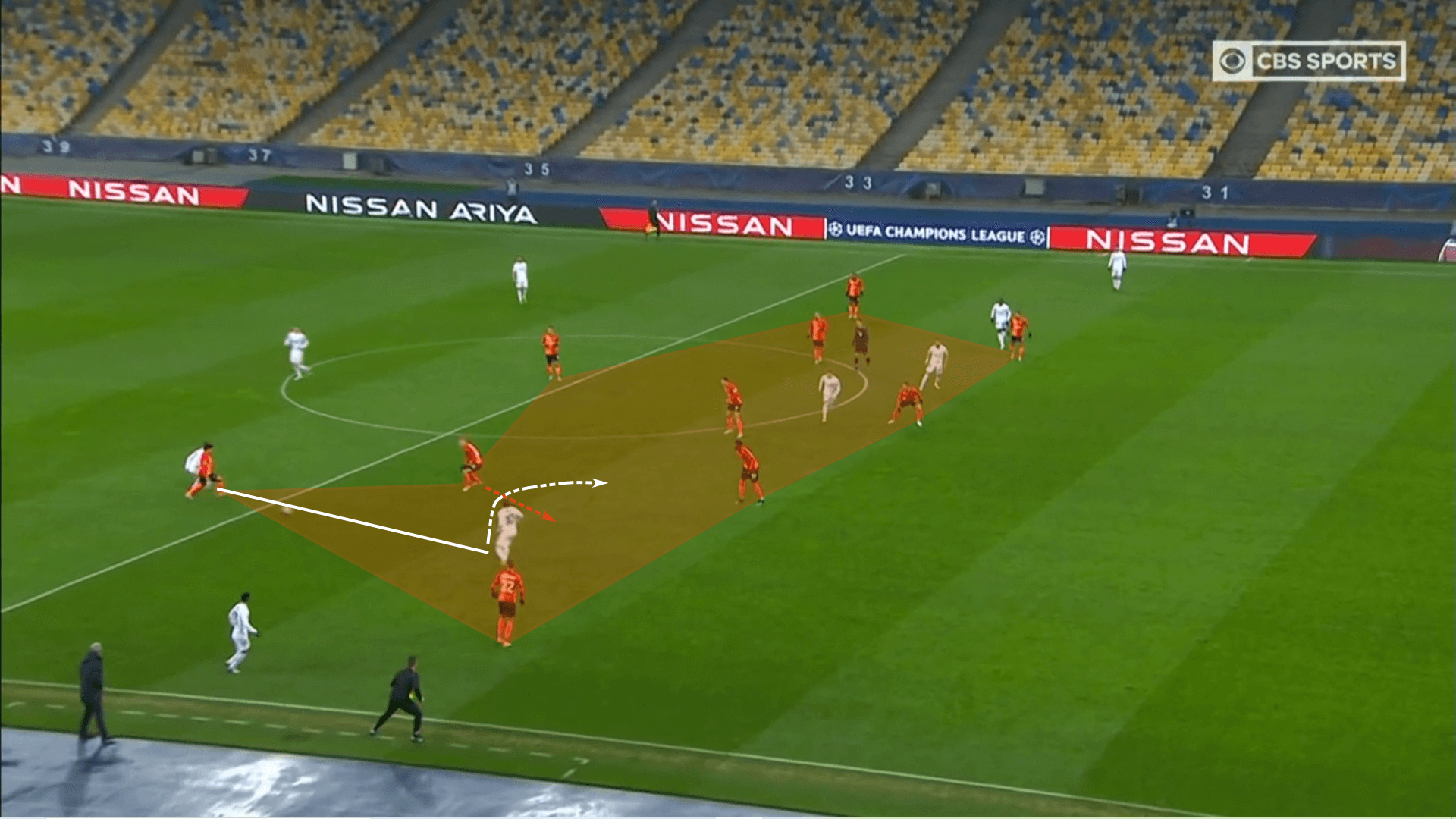
With Modrić receiving the ball in the half space, he cued Benzema and Ødegaard to make their runs behind the backline. In this example, Modrić pins a ball into the path of Benzema, sending the Frenchman into the box.
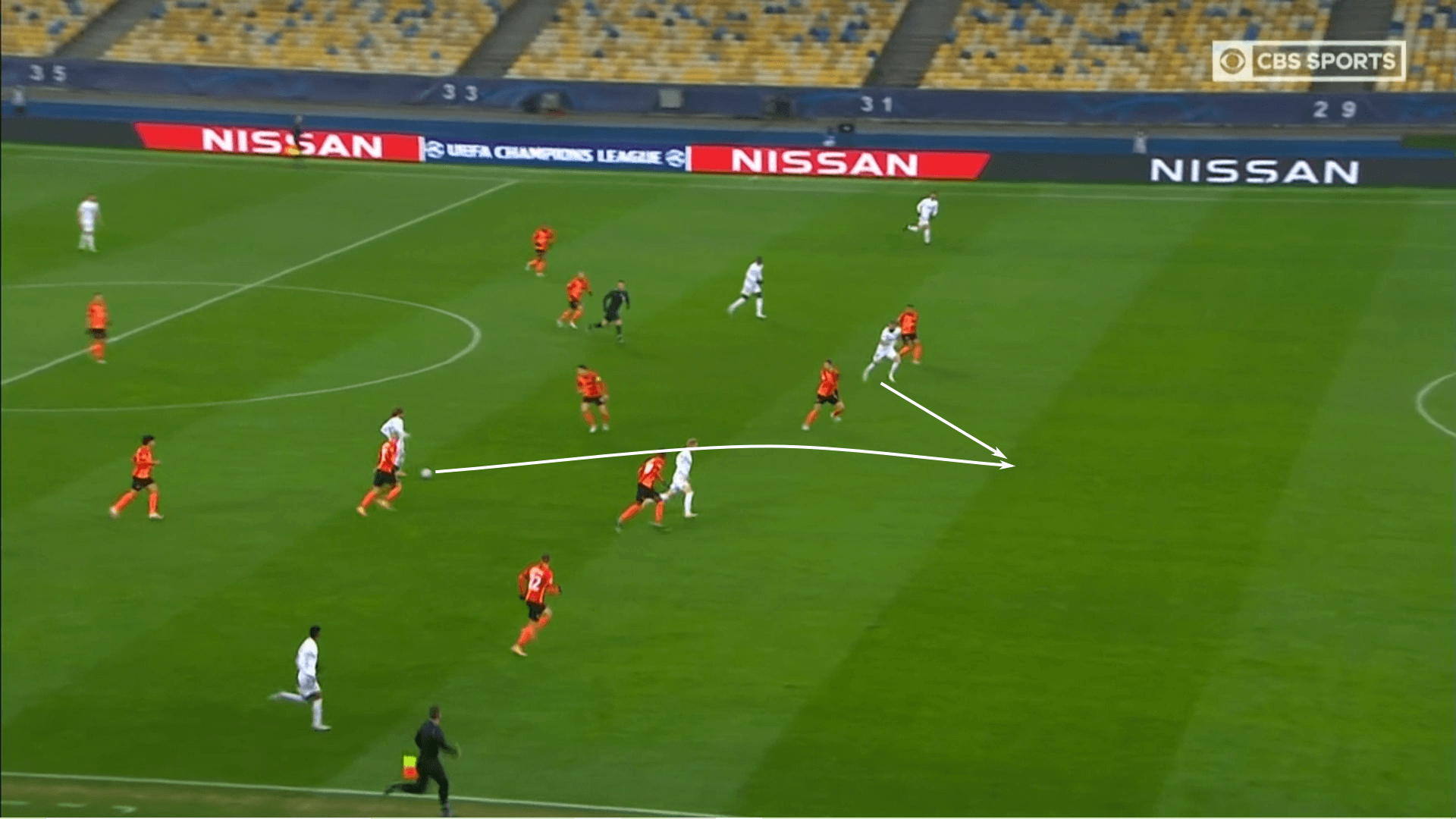
Whatever momentum they had in the first half, Madrid was unable to keep it in the second. With Shakhtar dropping a little bit deeper in the second half, the balls over the top were essentially out of the equation. Further, the Miners did a better job of denying half space entries to the high targets. That left Zidane’s side with the lone option of playing around the Shakhtar press.
With Real Madrid pushing their midfielders either behind or in front of Shakhtar’s midfield pressing structure, Shakhtar’s solution was to drop Stepanenko into the backline, giving them five players to cover the width of the pitch. That made half space entries to high targets far more difficult.
In the example below, we see how compact the backline is while also denying easy access to the central attacking players. Notice Shakhtar has five players to defend against Benzema and Asensio in the middle of the pitch. With virtually no one available in the central portion of the field, Real Madrid had to rely on the wingers to create opportunities to the goal.
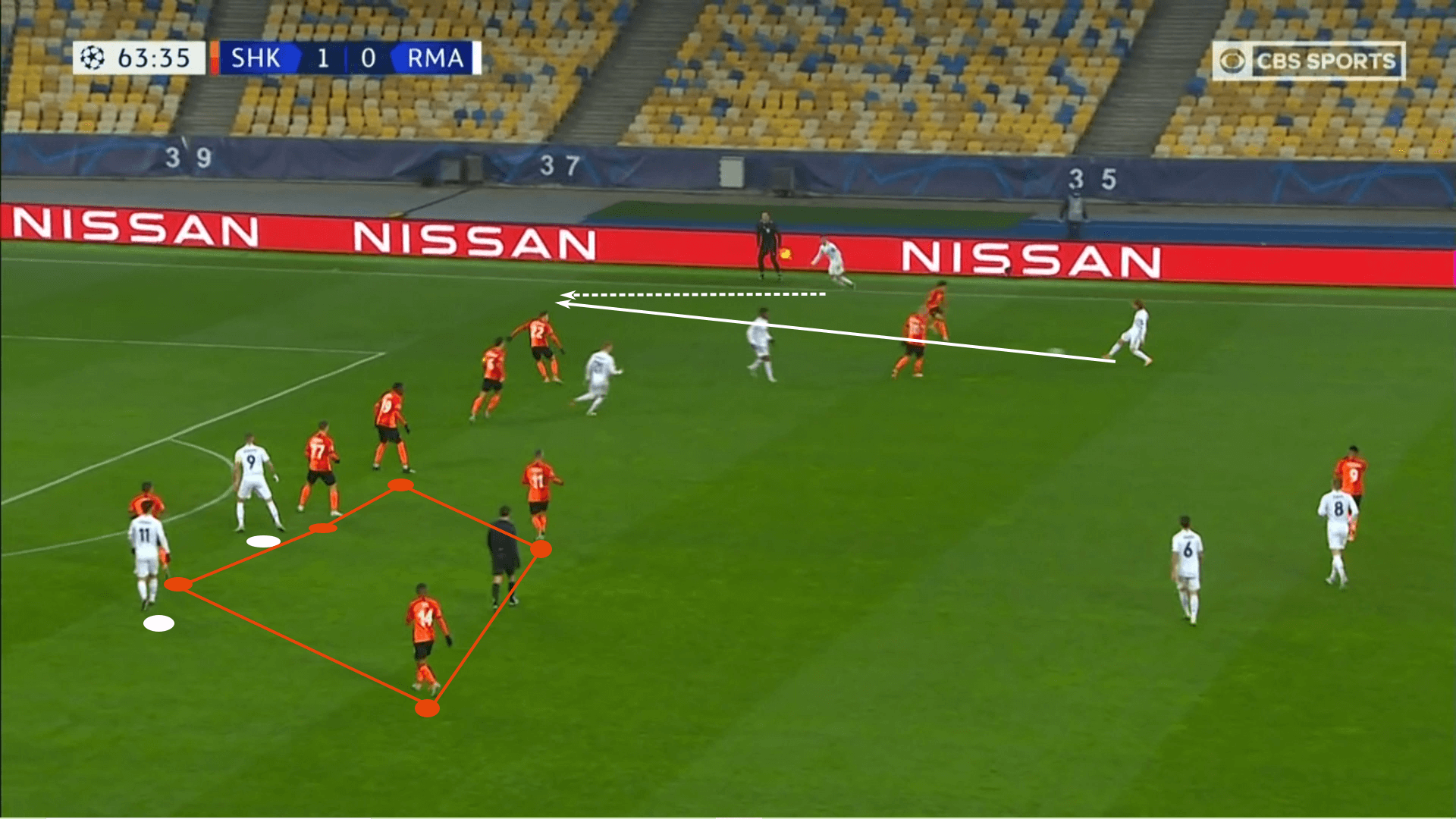
Of the 25 crosses Real Madrid sent in this match, only five were successful, a dismal 20% success rate. Vázquez’s cross in the image below capped off the sequence with a poor delivery directly into Stepanenko.
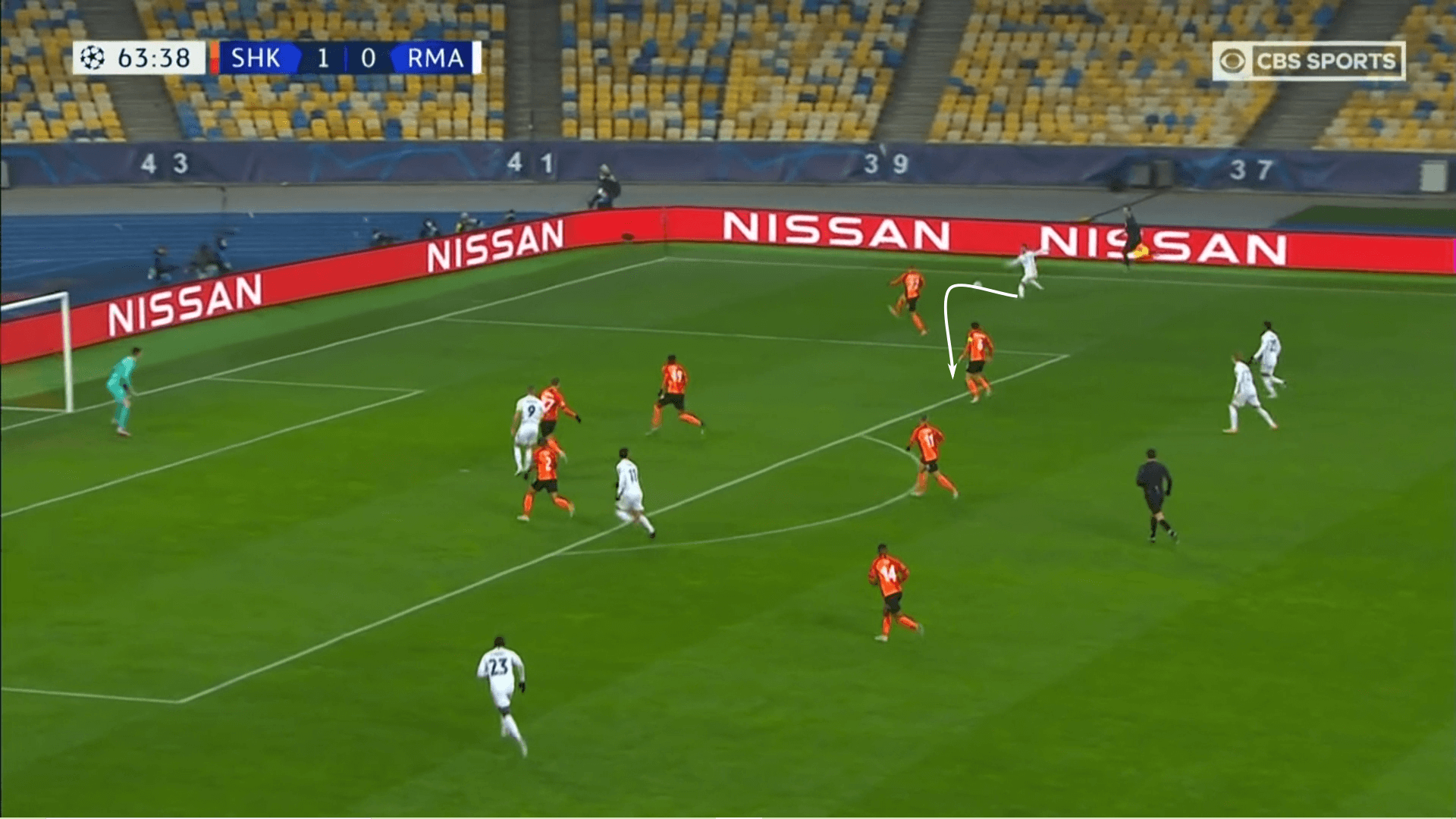
Quality of deliveries into the box was a massive issue for Madrid, but, even if the deliveries were of a higher quality, Shakhtar maintained numerical and qualitative advantages when defending against aerial passes into the box. The Ukrainians looked quite comfortable defending the onslaught of crosses. As the game progressed and Real Madrid ran out of ideas, the crosses became more frequent, increasing the ease of Shakhtar’s defensive work.
Conclusion
In the end, a catastrophic defensive sequence, which featured a miscommunication between Mendy and Varane in the box lead to Dentinho’s game-winning goal in the 57th minute. Shakhtar would capitalise on the counterattack in the 82nd minute with a goal from Manor Solomon. In the second instance, Real Madrid’s stretched press was unable to make up ground and engage Solomon until he was 1v1 in the box. The Israeli beat Courtois at the near post, securing three points for his team.
The win means that Shakhtar heads to Milan next week a win away from qualification. In their previous match against Inter Milan, the two sides play to a 0-0 draw. Now that Castro has some of his reinforcements back after a COVID-19 layoff, his side are heading into this pivotal match looking to deny an in-form Inter side.
For Real Madrid, the unthinkable is on the horizon. Anything less than a win against Borussia Mönchengladbach could see them finish 4th in the group, even missing the Europa League. They will host the Bundesliga side next week, but the side’s home struggles during the 2020/21 season have shown that this is not a given. If they can claim a victory, there’s still a good chance they can win the group, setting up an exciting finish in Group B.
They’ll take on Sevilla this Saturday. If you believe the rumours, Zidane’s job rests on results against both Sevilla and Mönchengladbach. Coming into the season, there were fewer managerial roles with a greater sense of safety. The players have already backed the manager and promised to fight for him. As they enter the most critical week of their season, we’ll see if they can right the ship and save the club legend’s job.





Comments